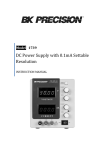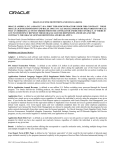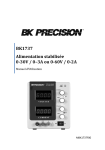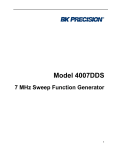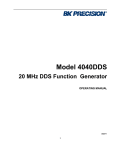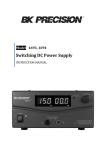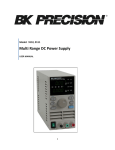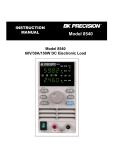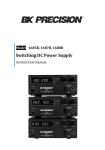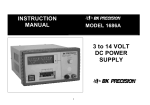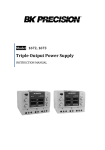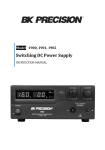Download B&K Precision 1737 Dual Range DC Power Supply
Transcript
Model 1737 Dual Range DC Power Supply INSTRUCTION MANUAL 1 Safety Summary The following safety precautions apply to both operating and maintenance personnel and must be observed during all phases of operation, service, and repair of this instrument. Before applying power, follow the installation instructions and become familiar with the operating instructions for this instrument. GROUND THE INSTRUMENT To minimize shock hazard, the instrument chassis and cabinet must be connected to an electrical ground. This instrument is grounded through the ground conductor of the supplied, three-conductor ac power cable. The power cable must be plugged into an approved three-conductor electrical outlet. Do not alter the ground connection. Without the protective ground connection, all accessible conductive parts (including control knobs) can render an electric shock. The power jack and mating plug of the power cable meet IEC safety standards. DO NOT OPERATE IN AN EXPLOSIVE ATMOSPHERE Do not operate the instrument in the presence of flammable gases or fumes. Operation of any electrical instrument in such an environment constitutes a definite safety hazard. KEEP AWAY FROM LIVE CIRCUITS Instrument covers must not be removed by operating personnel. Component replacement and internal adjustments must be made by qualified maintenance personnel. Disconnect the power cord before removing the instrument covers and replacing components. Under certain conditions, even with the power cable removed, dangerous voltages may exist. To avoid injuries, always disconnect power and discharge circuits before touching them. DO NOT SERVICE OR ADJUST ALONE Do not attempt any internal service or adjustment unless another person, capable of rendering first aid and resuscitation, is present. DO NOT SUBSTITUTE PARTS OR MODIFY THE INSTRUMENT Do not install substitute parts or perform any unauthorized modifications to this instrument. Return the instrument to B&K Precision for service and repair to ensure that safety features are maintained. 1 WARNINGS AND CAUTIONS WARNING and CAUTION statements, such as the following examples, denote a hazard and appear throughout this manual. Follow all instructions contained in these statements. A WARNING statement calls attention to an operating procedure, practice, or condition, which, if not followed correctly, could result in injury or death to personnel. A CAUTION statement calls attention to an operating procedure, practice, or condition, which, if not followed correctly, could result in damage to or destruction of parts or the entire product. WARNING: Do not alter the ground connection. Without the protective ground connection, all accessible conductive parts (including control knobs) can render an electric shock. The power jack and mating plug of the power cable meet IEC safety standards. WARNING: To avoid electrical shock hazard, disconnect power cord before removing covers. Refer servicing to qualified personnel. CAUTION: Before connecting the line cord to the AC mains, check the rear panel AC line voltage indicator. Applying a line voltage other than the indicated voltage can destroy the AC line fuses. For continued fire protection, replace fuses only with those of the specified voltage and current ratings. CAUTION: This product uses components which can be damaged by electrostatic discharge (ESD). To avoid damage, be sure to follow proper procedures for handling, storing and transporting parts and subassemblies which contain ESD-sensitive components. SAFETY SYMBOLS Connect to safety earth ground using the wire recommended in the user manual. This symbol on an instrument indicates that the user should refer to the operating instructions located in the manual. Certification We certify that this product met its published specifications at time of shipment from the factory. 2 Compliance Statements Disposal of Old Electrical & Electronic Equipment (Applicable in the European Union and other European countries with separate collection systems) This product is subject to Directive 2002/96/EC of the European Parliament and the Council of the European Union on waste electrical and electronic equipment (WEEE), and in jurisdictions adopting that Directive, is marked as being put on the market after August 13, 2005, and should not be disposed of as unsorted municipal waste. Please utilize your local WEEE collection facilities in the disposition of this product and otherwise observe all applicable requirements. 3 Contents 1 Safety Summary .......................................................... 1 2 Introduction ................................................................ 5 3 Quick Reference .......................................................... 6 4 5 6 7 3.1 3.2 Front Panel ......................................................................................... 6 Rear Panel .......................................................................................... 7 4.1 4.2 4.3 4.4 4.5 4.6 4.7 4.8 Instrument Hook-Up .......................................................................... 9 Typical Constant Voltage Operation................................................. 11 Setting Current Limit ........................................................................ 12 Typical Constant Current Operation ................................................ 13 Constant Voltage/Constant Current Characteristic.......................... 14 Saving the Power Supply’s Current State ......................................... 15 Connecting Two Power Supplies in Series ....................................... 15 Connecting Two Power Supplies in Parallel ..................................... 16 5.1 5.2 5.3 RS232 Configuration Overview ........................................................ 18 RS232 Commands ............................................................................ 18 Application Software ....................................................................... 19 6.1 6.2 6.3 6.4 Fuse Replacement............................................................................ 20 Adjustments ..................................................................................... 20 Calibration ....................................................................................... 21 Instrument Repair Service ............................................................... 26 7.1 7.2 7.3 Self-Test Errors ................................................................................. 27 Calibration Errors ............................................................................. 27 Command Errors .............................................................................. 28 Operating Instructions ................................................. 8 Remote Operation ......................................................17 Maintenance ..............................................................20 Error Messages ...........................................................27 8 Specifications .............................................................29 9 Service Information ....................................................31 10 Limited Two-Year Warranty........................................32 4 2 Introduction Description The B&K Precision model 1737 is a general purpose dual range DC power source. This power supply can output more voltage at a lower current or more current at a lower voltage. The 1737 provides 0-60 V DC output, adjustable with both coarse and fine voltage controls for precise setting. The current output for the 1737 is 0-3 A for the 0-30 V range, and 0-2 A for the 30-60 V range, adjustable with both coarse and fine current controls. The 1737 exhibits excellent regulation and low ripple characteristics. Its mechanical configuration conserves bench space and allows for easy portability. Additionally, the power supply can be operated locally from the front panel or remotely through the RS-232 interface. This power supply is well suited for a wide variety of electrical and electronics applications in service shops, engineering labs, production facilities, school laboratories, and home use. Features • • • • • • • • • • Low ripple and noise Excellent regulation Constant voltage (CV) and constant current (CC) operation Two 4-digit LED displays provide good visibility in bright or low light LED indication for CV and CC modes Automatic recall of last settings on power up RS-232 interface Isolated output Overload protection Reverse polarity protection 5 3 Quick Reference 3.1 Front Panel 5 3 1 6 7 4 8 2 9 10 11 12 Figure 1 - Front Panel INDICATORS Either the CV or CC LED indicators will be lit whenever the unit is operating. The unit automatically changes from CV to CC operation when the preset current limit is reached. 1) CV (Constant Voltage) Indicator. The green LED is lit in constant voltage mode. Unit regulates output voltage at the value set by voltage controls. 2) CC (Constant Current) Indicator. The red LED is lit in constant current mode. Unit regulates output current at the value set by current controls. 3) Green LED Display. 4-digit display continuously monitors voltage. 4) Red LED Display. 4-digit display continuously monitors current. VOLTAGE CONTROLS 5) Voltage Coarse Control. Coarse adjustment of output voltage. Read value on the green LED display. 6) Voltage Fine Control. Fine adjustment of output voltage. Read value on the green LED display. 6 CURRENT CONTROL 7) Current Coarse Control. Coarse adjustment of current limit. Read value on the red LED display. 8) Current Fine Control. Fine adjustment of current limit. Read value on the red LED display. POWER CONTROLS 9) Power ON-OFF Switch. OUTPUT TERMINALS 10) “-” Terminal (Black). Negative polarity output terminal. 11) GND Terminal. Earth and chassis ground. 12) “+” Terminal (Red). Positive polarity output terminal. 3.2 Rear Panel 13 15 14 Figure 2 - Rear Panel 13) Power Cord 14) Fuse 15) RS-232 Interface Connector 7 4 Operating Instructions Safety Precautions Use only a polarized 3-wire AC outlet. This assures that the power supply chassis, case, and ground terminal are connected to a good earth ground and reduces danger from electrical shock. There is little danger of electrical shock from the power supply output, which produces a maximum of 60 volts dc. However, there may be great danger of electrical shock if the power supply output is connected to an external high voltage. Some equipment being powered may contain high voltage and present a shock hazard. Observe caution. If the power supply output is floated (referenced to a voltage rather than earth ground) turn off the power supply and the equipment under test when making connections. Never float the power supply to a potential greater than 100 volts peak with respect to earth ground. Equipment Precautions Avoid using the power supply in ambient temperatures above +40° C. Always allow sufficient air space around the heat sink at the rear of the power supply for effective radiation to prevent internal heat build-up. Although the power supply is protected against reverse polarity damage, the circuit being powered may not include such protection. Always carefully observe polarity; incorrect polarity may damage the equipment under test. Do not exceed the voltage rating of the circuit being powered. Many transistors and integrated circuits will not withstand voltage of 60 volts. There is no need to worry about voltage spikes or overshoot damaging the equipment under test. The voltage between the output terminals of the power supply never exceeds the preset value as the POWER switch is turned on or off. 8 4.1 Instrument Hook-Up 1. 2. 3. 4. Turn off the power supply and the equipment to be powered during hookup. Connect the positive polarity of the device being powered to the red (+) terminal of the power supply. Connect the negative polarity of the device being powered to the black (-) terminal of the power supply. Figure 3 illustrates the grounding possibilities. a. If the negative polarity of the equipment or circuit being powered is also the chassis or common, it may be grounded to earth by strapping the black (-) terminal to the green ( ) terminal as shown in Figure 3A. b. Similarly, the positive polarity can be grounded by strapping the red (+) terminal to the green ( ) terminal as shown in Figure 3B. c. If an earth ground reference is not required, the configuration of Figure 3C may be used. The scheme in Figure 3C should also be used where it is not known whether the chassis is common with either the positive or negative polarity. d. If the chassis or common of the equipment being powered is separate from both the positive and negative polarity power inputs, use the connection shown in Figure 3D. 6. Observe proper polarity. If the circuit being powered is not equipped with reverse polarity protection, damage to the circuit can result from reverse polarity. Use color coded hook-up leads, for convenience in identifying polarity, red for (+) and black for (-). 7. Make sure that the hook-up leads offer sufficient current capability and low resistance between the power supply and the circuits being powered. 9 Figure 3 (A and B) - Grounding Possibilities Figure 3 (C and D) - Grounding Possibilities 10 4.2 Typical Constant Voltage Operation 1. 2. 3. 4. 5. 6. 7. Before connecting the device to be powered to the power supply, determine the maximum safe load current for the device to be powered and set the current limit value (see Setting Current Limit procedure in this section). The output voltage can be set using the voltage coarse knob (with a 1 V resolution) and voltage fine knob (with a 10 mV resolution). After the last adjustment you must wait 3 seconds until the state is saved. Turn off power supply and connect it to the device to be powered (see Instrument Hook-Up procedure in this section). Turn on the power switch. The CV indicator should light. Increase the voltage setting until the voltage LED display reads the desired value. The fine control permits easier setting to a specific value. Note the load current on the current LED display. If the load current exceeds the preset current limit, the CV indicator will go off and the CC indicator will light. In this case, the power supply automatically switches to the constant current mode, and further rotation of the voltage control will not increase the output voltage. Figure 4 - Typical Constant Voltage Operation 11 4.3 Setting Current Limit 1. 2. 3. 4. 5. Determine the maximum safe current for the device to be powered. Temporarily short the (+) and (-) terminals of the power supply together with a test lead. Adjust the coarse and fine current control for the desired current limit. Read the current value on the current LED display. The current limit (overload protection) has now been preset. Do not change the current controls settings after this step. Remove the short between the (+) and (-) terminals and hook up for constant voltage operation. Figure 5 - Setting Current Limit 12 4.4 Typical Constant Current Operation 1. 2. 3. 4. 5. 6. 7. Before connecting the device to be powered to the power supply, determine the maximum safe voltage to be applied, and set the voltage controls to obtain that voltage reading on the voltage LED display. Determine the desired constant current value. Set the coarse and fine current control to minimum (1 mA). Wait 3 seconds. Turn off the power supply and connect it to the device to be powered. Turn on the power supply. The CC indicator should light. Increase the coarse and fine current control setting until the desired constant current value is read on the display, or set the current limit in advance (before connecting the load) as described earlier in the Setting Current Limit procedure. If the load current drops below the constant current value, the CC indicator will go off and the CV indicator will light. In this case, the power supply automatically switches to the constant voltage mode, and further rotation of the current controls will not increase the output current. Figure 6 - Typical Constant Current Operation 13 4.5 Constant Voltage/Constant Current Characteristic The working characteristic of this power supply is called a constant voltage/constant current automatic crossover type. This permits continuous transition from constant current to constant voltage modes in response to the load change. The intersection of constant voltage and constant current modes is called the crossover point. Figure 7 shows the relationship between this crossover point and the load. For example, if the load is such that the power supply is operating in the constant voltage mode, a regulated output voltage is provided. The output voltage remains constant as the load decreases, up until the point where the preset current limit is reached. At that point, the output current becomes constant and the output voltage drops in proportion to further decreases in load. The crossover point is indicated by the front panel LED indicators. The crossover point is reached when the CV indicator goes off and the CC indicator comes on. Similarly, crossover from the constant current to the constant voltage mode automatically occurs from an increase in load. A good example of this would be seen when charging a 12-volt battery. Initially, the open circuit voltage of the power supply may be preset for 13.8 volts. A low battery will have a low load on the supply and it will operate in the constant current mode, which may be adjusted for a 1 amp charging rate. As the battery becomes charged, and its voltage approaches 13.8 volts, its load increases to the point where it no longer demands the full 1 amp charging rate. This is the crossover point where the power supply goes into the constant voltage mode. Figure 7 - Constant Voltage/Constant Current Characteristic 14 4.6 Saving the Power Supply’s Current State The current state of the power supply is saved after 2 seconds from the last adjustment or after the “SAVE” command is received through the RS232 interface. 4.7 Connecting Two Power Supplies in Series Two power supplies may be connected in series to provide a variable 0-120 V output. In this configuration, the two power supplies can supply up to 60 V-3 A or 120 V-2 A. See Figure 8 for the connection scheme. When connected in series, the voltage controls of each power supply exercise control over a 0-60 V range. Add the LED display readings together or connect an external voltmeter across the load to determine the total output voltage. Load current may be monitored from either supply; the readings will be identical since they are connected in series. Also, since the supplies are connected in series, it is only necessary to set the current limit on one of the supplies; the other may be set for maximum. Figure 8 - Connecting Two Power Supplies in Series 15 4.8 Connecting Two Power Supplies in Parallel Two power supplies may be connected in parallel to double the maximum load current. In this configuration, the two power supplies will provide 0-60 V output at up to 4 A or 0-30 V at 6 A (heavier gauge hook-up leads are advisable). Current equalizing resistors must be used as shown in Figure 9. However, the protective current limiting feature will prevent damage if current is temporarily unbalanced during set-up. When connected in parallel and operating in the constant voltage mode, determine the total load current limit and preset the current limiting for each power supply to half the total load current value. Then when the load is connected, set the voltage controls on the two power supplies for equal voltage readings. This should also provide approximately equal current from each supply. Add the two current meter readings together for total load current, or connect an external ammeter in series with the load. Figure 9 - Connecting Two Power Supplies in Parallel 16 If the current equalizing resistors are not well matched, it is preferable that the voltages be slightly unbalanced to achieve current balance. Be sure that the supplies are adequately balanced so that both remain in the CV mode. When connected in parallel and operating in the constant current mode, the voltage controls of both supplies should be preset to the same value. Then when the load is connected, the current controls of the two supplies should be adjusted for approximately equal current from each unit. Be sure that both supplies remain in the CC mode. 5 Remote Operation The power supply can be connected to the RS232 interface using the 9-pin (DB-9) serial connector on the rear panel. The 1737 uses a null modem RS232 cable. The cable pin diagram for the DB-9 connector is shown in the picture below: Instrument RX PC 2 3 RX TX 2 3 GND 5 5 GND DB-9 connector TX DB-9 connector Figure 10 - RS232 Cable Pin Diagram For all communications over the RS232 interface, the power supply uses Xon/Xoff protocol. NOTE: If using HyperTerminal, make sure you properly configure the “ASCII Setup”. In “ASCII Setup”, do not append line feeds to “ASCII Sending”. “Echo typed characters locally” can be checked, but “Send line ends with line feeds” should be left unchecked. In “ASCII Receiving”, “Append line feeds to incoming line ends” can also be checked. 17 5.1 RS232 Configuration Overview Baud Rate 9600 bps Parity Bits none Data Bits 8 Start Bits 1 Stop Bits 1 Flow Control Xon / Xoff Termination Character \r Table 1 - RS232 Configuration 5.2 RS232 Commands 1.VOLT xx.xx<CR> This command sets the output voltage value. The output voltage takes the programmed value only if the power supply is in Constant Voltage mode. Example: The output voltage is set at 5 V. VOLT 05.00<CR> 2. CURR x.xxx<CR> This command sets the output current value. The output current takes the programmed value only if the power supply is in Constant Current mode. Example: The output current is set at 300 mA. CURR 0.300<CR> 18 3. SAVE<CR> The programmed values of the output current and voltage are saved. If the power supply is restarted, the values of the output current and voltage will be those previously saved. 4. VOLT?<CR> This command returns the voltage measured to the output terminals of the power supply: xx.xxV<CR> The voltage value returned is the same as the one displayed on the voltage display. 5. CURR?<CR> This command returns the current measured to the output terminals of the power supply: x.xxxA<CR> The current value returned is the same as the one displayed on the current display. 6. STAT?<CR> The power supply responds to this command with one of the following messages: CV<CR> if the power supply is in Constant Voltage mode CC<CR> if the power supply is in Constant Current mode 5.3 Application Software Remotely control your 1737 using B&K Precision’s application software, available for download at www.bkprecision.com. This software provides a virtual front panel and a simple data logging function to store and log data to a text or CSV file. RS232 commands can also be sent through the software. 19 6 Maintenance WARNING The following instructions are for use by qualified personnel only. To avoid electrical shock, do not perform any servicing other than contained in the operating instructions unless you are qualified to do so. 6.1 Fuse Replacement If the fuse blows, the CV or CC indicators will not light and the power supply will not operate. The fuse should not normally open unless a problem has developed in the unit. Try to determine and correct the cause of the blown fuse, then replace only with a fuse of the correct rating as listed below. The fuse is located on the rear panel (see Figure 2). Line Voltage Fuse Type 120 Vac ± 10%, 50/60 Hz 2.5A Slow Blow 220 Vac ± 10%, 50/60 Hz 1.25A Slow Blow Table 2 - Fuse Values Line Voltage Conversion, International Units The primary winding of the power transformer is tapped to permit operation from 120/220/230 or 240 VAC, 50/60 Hz line voltage. Conversion from one line voltage to another is done by a simple position change of the fuse receptacle underneath the line cord. 6.2 Adjustments This unit was accurately adjusted at the factory before shipment. Readjustment is recommended only if repairs have been made in a circuit affecting adjustment accuracy, or if you have a reason to believe the unit is out of adjustment. However, adjustments should be attempted only if a multimeter with an accuracy of ±0.02% DCV or better is available (B&K Precision Model 5491B or equivalent). 20 6.3 Calibration Calibration is a procedure that ensures that the power supply will work properly, with parameters specified within the Specifications section. Before initiating the calibration procedure, the following conditions must be assured: • Disconnect any loads connected to the power supply and turn it on • Let the power supply be turned on for 1 hour with no loads connected before you start the calibration procedure • Calibration ambient temperature must be 25°C • Ambient relative humidity must be less than 80% To calibrate the power supply, complete the following steps: 1. Turn on the power supply in calibrating mode 2. Zero voltage calibration 3. Full voltage calibration 4. Zero current calibration 5. Full current calibration 6. Leaving the Calibration menu Figure 11 - Location of Adjustments 21 1. Turn on the power supply in calibrating mode a) Turn off the power supply. Disconnect the power cord and all loads connected to the power supply. b) Remove power supply’s cover. c) Set the calibration jumper as shown in Figure 11. d) Reassemble the power supply. e) Connect the power cord to the power supply. f) Turn on the power supply in Calibration menu. The power supply will display: Voltage display: C A L Current display: U 0 You can browse the calibration menu by turning the current coarse knob. Using the voltage coarse knob you can select one of the following calibration procedures: U U I I 0 F 0 F Zero voltage calibration Full voltage calibration Zero current calibration Full current calibration The voltage fine and current fine knobs are not used. Important note! In order to perform a correct calibration procedure, you must select the full voltage calibration option just after the zero voltage calibration option, and the full current calibration option just after the zero current calibration option. 22 2. Zero voltage calibration a) Turn the current coarse knob to select “U 0” for zero voltage calibration and turn the voltage coarse knob. The power supply will display: Voltage display: U 0 Current display: hex number On the current display, a hexadecimal number between 0 and FFFFh is displayed. During the zero voltage calibration, the CV LED is lit. b) Connect a digital voltmeter to the output terminals of the power supply (B&K Precision 5491B or similar instrument). c) Use the current coarse and fine knobs to adjust the value displayed by the power supply until the voltmeter indicates the closest value to 0 V. d) Turn the voltage coarse knob to finish the calibration. While performing the zero voltage calibration, the current display will show Adc. After the zero voltage calibration, the message Done is shown on the current display for 1 sec. Then the power supply returns to the Calibration menu. 3. Full voltage calibration To finish the voltage calibration procedure, the full voltage calibration must be done after the zero voltage calibration. a) Select “U F” for full voltage calibration and turn the voltage coarse knob. The power supply will display: Voltage display: U F Current display: hex number 23 A hexadecimal number between 0 and FFFFh will be shown on the current display. During the zero voltage calibration, the CV LED is lit. b) Connect a digital voltmeter to the output terminals of the power supply (B&K Precision 5491B or similar instrument). c) Use the current coarse and fine knobs to adjust the value displayed by the power supply until the voltmeter indicates the value to 60.882 V. d) Turn the voltage coarse knob to finish the calibration. While performing the full voltage calibration the current display will show Adc. After the full voltage calibration the message Done is shown on the current display for 1 sec. Then the power supply returns to the Calibration menu. 4. Zero current calibration a) Select “I 0” for zero current calibration and turn the voltage coarse knob. When you initiate the zero current calibration, the CV LED lights up and the power supply will display: Voltage display: I 0 Current display: ConA b) Connect a digital ammeter (B&K Precision 5491B or similar instrument) to the output terminals of the power supply to initiate the zero current calibration procedure. If a digital ammeter is not connected within 30 seconds, the power supply will abandon the current calibration procedure and return to the Calibration menu. The CV LED indicator will go off and the CC LED indicator will light on. The power supply will then display: Voltage display: I 0 Current display: hex number 24 A hexadecimal number between 0 and FFFFh is shown on the current display. c) Use the current coarse and fine knobs to adjust the value displayed by the power supply until the ammeter indicates the closest value to 0 A. d) Turn the voltage coarse knob to finish the calibration. While performing the zero current calibration, the current display will show Adc. After the zero current calibration, the message Done is shown on the current display for 1 sec. Then the power supply returns to the Calibration menu. 5. Full current calibration To finish the current calibration procedure, you must select the full current calibration option after the zero current calibration. a) Select “I F” for full current calibration and turn the voltage coarse knob. When you initiate the full current calibration, the CV LED lights up and the power supply will display: Voltage display: I F Current display: ConA b) Connect a digital ammeter (BK Precision 5491B or similar instrument) to the output terminals of the power supply to initiate the full current calibration procedure. If a digital ammeter is not connected within 30 seconds, the power supply will abandon the current calibration procedure and will return to the Calibration menu. The CV LED indicator will turn off and the CC LED indicator will light on. The power supply will then display: Voltage display: I F Current display: hex number 25 A hexadecimal number between 0 and FFFFh is shown on the current display. c) Use the current coarse and fine knobs to adjust the value displayed by the power supply until the ammeter indicates the value to 3.0801 A. d) Turn the voltage coarse knob to finish the calibration. While performing the full current calibration, the current display will show Adc. After the full current calibration, the message Done is shown on the current display for 1 sec. The power supply does not return to the Calibration menu because the calibration procedure is finished and the power supply must be turned off. 6. Leaving the calibration menu a) After turning off the power supply, disconnect the power cord. b) Remove power supply’s cover. c) Remove the calibration jumper. d) Reassemble the power supply. e) Connect the power cord. f) When turned on, the power supply will have the same parameters programmed and saved before the calibration procedure. 6.4 Instrument Repair Service Because of the specialized skills and test equipment required for instrument repair and calibration, many customers prefer to rely upon B&K Precision for this service. We maintain a network of B&K Precision authorized service agencies for this purpose. To use this service, even if the instrument is no longer under warranty, follow the instructions given in the Warranty Service Instructions section of this manual. There is a nominal charge for instruments out of warranty. 26 7 Error Messages The following types of errors may occur: • Self-test errors • Calibration errors • Command errors The first two types of errors are displayed on the voltage display as: Er xx, where xx is a number. The command errors are sent through the RS232 interface. 7.1 Self-Test Errors Er 01: EEPROM does not respond Er 02: CV not high Er 03: CV not low Er 04: CC not high Er 05: CC not low Er 06: ADC does not respond Er 07: ADC not ready Er 08: No reference voltage Er 09: ADC conversion error Er 10: ADC AVdd< 3.0V Er 11: ADC AVdd> 3.6V Er 12: Calibration constants checksum failed 7.2 Calibration Errors Zero voltage calibration errors Er 20: CC not high Er 21: CV not low Er 22: DAC out of range Er 23: ADC out of range Er 24: ADC system calibration failed Er 25: DAC zero voltage constant checksum failed Er 26: ADC zero voltage constant checksum failed 27 Full voltage calibration errors: Er 30: CC not high Er 31: CV not low Er 32: DAC out of range Er 33: ADC out of range Er 34: ADC system calibration failed Er 35: DAC full voltage constant checksum failed Er 36: ADC full voltage constant checksum failed Zero current calibration errors: Er 40: CC not low Er 41: CV not high Er 42: DAC out of range Er 43: ADC out of range Er 44: ADC system calibration failed Er 45: DAC zero current constant checksum failed Er 46: ADC zero current constant checksum failed Full current calibration errors: Er 50: CC not low Er 51: CV not high Er 52: DAC out of range Er 53: ADC out of range Er 54: ADC system calibration failed Er 55: DAC full current constant checksum failed Er 56: ADC full current constant checksum failed 7.3 Command Errors ”Communication Error<CR>” “Syntax Error<CR>” “Out of range<CR>” : RS232 framing, parity, or overrun error : invalid syntax was found in the command string : a numeric parameter value is outside the valid range for the command 28 8 Specifications 1737 Output Ratings ( 0 °C~40 °C) 0-60 V 0-3 A (0-30 V), 0-2 A (30-60 V) Voltage Current Load Regulation ±(% of output+offset) Voltage Current Line Regulation ±(% of output+offset) 0.01% + 3 mV 0.2% + 3 mA Voltage Current Ripple & Noise (20 Hz ~ 20 MHz) 0.01% + 3 mV 0.2% + 3 mA Voltage Current Recovery Time Meter Resolution 1 mVrms ≤ 3 mArms ≤ 100 μs Voltage Current Metering Accuracy 10 mV 1 mA 0.5% + 9 digits 0.5% + 9 digits Voltage Current General Power Requirements Power Consumption Protection Operating Environment Temperature Humidity Temperature coefficient (0 °C~35 °C) ±(%of output+offset) 120/220 VAC ±10%, 50/60 Hz ≤ 180 W Reverse polarity, current limiting 32 °F to 104 °F (0 °C to 40 °C) 75% R.H. 300 ppm/°C Storage Temperature 5 °F to 158 °F (-15° to +70° C) 29 Storage Humidity Mechanical Specifications 85% R.H. 10.5 lbs (4.8 kg) 5.5” x 6.2” x 12.5" (140 x 158 x 318 mm) Power cord, instruction manual, RS-232 cable, shorting bar Weight Dimensions (W x H x D) Supplied Accessories NOTE: All specifications apply to the unit after a temperature stabilization time of 30 minutes. Specifications and information are subject to change without notice. To ensure the most current version of this manual, please download the current version here: http://www.bkprecision.com/search/manual/1737 For current up-to-date product information, please visit www.bkprecision.com 30 9 Service Information Warranty Service: Please go to the support and service section on our website at www.bkprecision.com to obtain an RMA #. Return the product in the original packaging with proof of purchase to the address below. Clearly state on the RMA the performance problem and return any leads, probes, connectors, and accessories that you are using with the device. Non-Warranty Service: Please go to the support and service section on our website at www.bkprecision.com to obtain an RMA #. Return the product in the original packaging to the address below. Clearly state on the RMA the performance problem and return any leads, probes, connectors, and accessories that you are using with the device. Customers not on an open account must include payment in the form of a money order or credit card. For the most current repair charges, please refer to the service and support section on our website. Return all merchandise to B&K Precision Corp. with pre-paid shipping. The flat-rate repair charge for Non-Warranty Service does not include return shipping. Return shipping to locations in North America is included for Warranty Service. For overnight shipments and non-North American shipping fees, please contact B&K Precision Corp. B&K Precision Corp. 22820 Savi Ranch Parkway Yorba Linda, CA 92887 www.bkprecision.com 714-921-9095 Include with the returned instrument your complete return shipping address, contact name, phone number, and description of problem. 31 10 Limited Two-Year Warranty B&K Precision Corp. warrants to the original purchaser that its products and the component parts thereof will be free from defects in workmanship and materials, for a period of two years from date of purchase. B&K Precision Corp. will, without charge, repair or replace, at its option, defective product or component parts. Returned product must be accompanied by proof of the purchase date in the form of a sales receipt. To obtain warranty coverage in the U.S.A., this product must be registered by completing a warranty registration form on our website at www.bkprecision.com within fifteen (15) days of purchase. Exclusions: This warranty does not apply in the event of misuse or abuse of the product or as a result of unauthorized alterations or repairs. The warranty is void if the serial number is altered, defaced, or removed. B&K Precision Corp. shall not be liable for any consequential damages, including without limitation, damages resulting from loss of use. Some states do not allow limitations of incidental or consequential damages. So the above limitation or exclusion may not apply to you. This warranty gives you specific rights and you may have other rights, which vary from state-to-state. B&K Precision Corp. 22820 Savi Ranch Parkway Yorba Linda, CA 92887 www.bkprecision.com 714-921-9095 32 (Page intentionally left blank) 33 22820 Savi Ranch Parkway Yorba Linda, CA 92887 www.bkprecision.com © 2011 B&K Precision Corp. Printed in Taiwan v063011




































